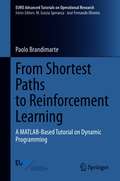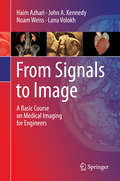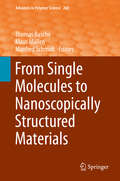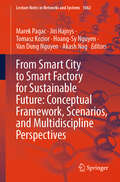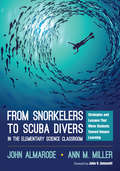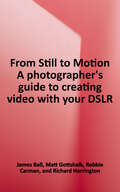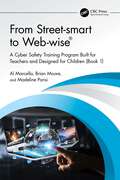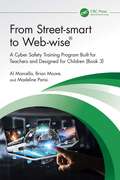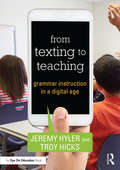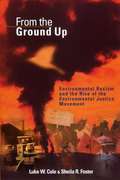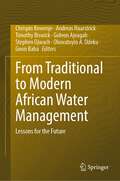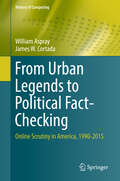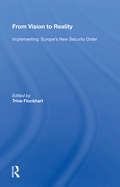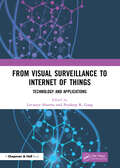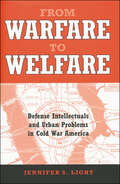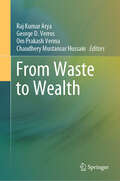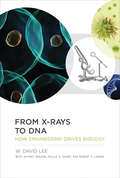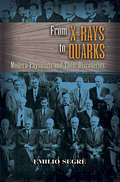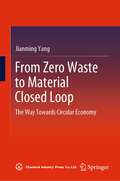- Table View
- List View
From Seed to Plant (Journeys 2014)
by Gail GibbonsFlowers, trees, fruits—plants are all around us, but where do they come from? With simple language and bright illustrations, non-fiction master Gail Gibbons introduces young readers to the processes of pollination, seed formation, and germination. Important vocabulary is reinforced with accessible explanation and colorful, clear diagrams showing the parts of plants, the wide variety of seeds, and how they grow. The book includes instructions for a seed-growing project, and a page of interesting facts about plants, seeds, and flowers. A nonfiction classic, and a perfect companion for early science lessons and curious young gardeners. According to The Washington Post, Gail Gibbons "has taught more preschoolers and early readers about the world than any other children's writer-illustrator." Ms. Gibbons is the author of more than 100 books for young readers, including the bestselling titles From Seed to Plant and Monarch Butterfly. Her many honors include the Washington Post/Childrens Book Guild Nonfiction Award and the NSTA Outstanding Science Trade Book Award. From Seed to Plant was included in the Common Core State Standards Appendix B.
From Shortest Paths to Reinforcement Learning: A MATLAB-Based Tutorial on Dynamic Programming (EURO Advanced Tutorials on Operational Research)
by Paolo BrandimarteDynamic programming (DP) has a relevant history as a powerful and flexible optimization principle, but has a bad reputation as a computationally impractical tool. This book fills a gap between the statement of DP principles and their actual software implementation. Using MATLAB throughout, this tutorial gently gets the reader acquainted with DP and its potential applications, offering the possibility of actual experimentation and hands-on experience. The book assumes basic familiarity with probability and optimization, and is suitable to both practitioners and graduate students in engineering, applied mathematics, management, finance and economics.
From Signals to Image: A Basic Course on Medical Imaging for Engineers
by Haim Azhari John A. Kennedy Noam Weiss Lana VolokhThis textbook, intended for advanced undergraduate and graduate students, is an introduction to the physical and mathematical principles used in clinical medical imaging. The first two chapters introduce basic concepts and useful terms used in medical imaging and the tools implemented in image reconstruction, while the following chapters cover an array of topics such as: physics of x-rays and their implementation in planar and computed tomography (CT) imaging;nuclear medicine imaging and the methods of forming functional planar and single photon emission computed tomography (SPECT) images and Clinical imaging using positron emitters as radiotracers. The book also discusses the principles of MRI pulse sequencing and signal generation, gradient fields, and the methodologies implemented for image formation, form flow imaging and magnetic resonance angiography and the basic physics of acoustic waves, the different acquisition modes used in medical ultrasound, and the methodologies implemented for image formation and for flow imaging using the Doppler Effect.By the end of the book, readers will know what is expected from a medical image, will comprehend the issues involved in producing and assessing the quality of a medical image, will be able to conceptually implement this knowledge in the development of a new imaging modality, and will be able to write basic algorithms for image reconstruction. Knowledge of calculus, linear algebra, regular and partial differential equations, and a familiarity with the Fourier transform and it applications is expected, along with fluency with computer programming. The book contains exercises, homework problems, and sample exam questions that are exemplary of the main concepts and formulae students would encounter in a clinical setting.
From Single Molecules to Nanoscopically Structured Materials
by Thomas Basché Klaus Müllen Manfred SchmidtMechanical Properties of Single Molecules and Polymer Aggregates Rüdiger Berger, Kurt Binder, Gregor Diezemann, Jürgen Gauß, Mark Helm, Katharina Landfester, Wolfgang Paul (Halle), Peter Virnau. Optical Properties of Individual Molecular Aggregates and Nano Particles Thomas Basché, Hans-Jürgen Butt, Gregor Diezemann, Jürgen Gauß, Klaus Müllen, Harald Paulsen, Carsten Sönnichsen, Rudolf Zentel. Structure Formation of Polymeric Building Blocks I: Self-assembly of Copolymers Kurt Binder, Holger Frey, Andreas Kilbinger (Univ. Fribourg), Ute Kolb, Michael Maskos (IMM Mainz), Wolfgang Paul (Univ. Halle), Hans Wolfgang Spiess. Structure Formation of Polymeric Building Blocks II: Complex Polymer Architectures Kurt Binder, Hans Jürgen Butt, Angelika Kühnle, Klaus Müllen, Wolfgang Paul (Univ. Halle), Erwin Schmidt, Manfred Schmidt, Hans Wolfgang Spiess, Thomas Vilgis. Structure Formation of Polymeric Building Blocks III: Polymer Complexes in Biological Applications Kurt Kremer, Heiko Luhmann, Christine Peter, Friederike Schmid, Erwin Schmidt, Manfred Schmidt, Eva Sinner (Univ. of Natural Resources, Vienna), Tanja Weil (Univ. Ulm).
From Smart City to Smart Factory for Sustainable Future: Conceptual Framework, Scenarios, and Multidiscipline Perspectives (Lecture Notes in Networks and Systems #1062)
by Marek Pagac Jiri Hajnys Tomasz Kozior Hoang-Sy Nguyen Van Dung Nguyen Akash NagThis volume includes the proceedings of the 2nd International Conference on "From Smart City to Smart Factory for a Sustainable Future" (SCFF24), held at VSB - Technical University of Ostrava from May 14 to 16, 2024. The conference was organized in collaboration with university and institute partners from Czech Republic, Poland, India, and Vietnam. SCFF24 covers a broad range of topics, with a particular focus on the application of technologies in Smart Cities and Smart Factories to achieve a Sustainable Future. The Conference aims to bring together participants from diverse fields to share their knowledge, innovative ideas, and solutions to current challenges that hinder progress toward a more modern and sustainable life that we all share. In light on this, it also serves as a platform for the mutual exchange of experiences and the formation of enduring international collaborations. This book offers a comprehensive and multi-perspective view, providing readers with insights into the latest technological possibilities from voices around the world, with the hope of raising awareness and fostering further advancements in these fields.
From Snorkelers to Scuba Divers in the Elementary Science Classroom: Strategies and Lessons That Move Students Toward Deeper Learning
by John T. Almarode Ann M. MillerInspire a deep and lasting love of science in young students The way students view scientific knowledge is largely dependent on their early experiences with science instruction. With so much attention paid to student performance relative to the rest of the world, it is imperative for science teachers to engage elementary learners in ways that foster prolonged interest, deep conceptual understanding, and success in middle and high school as well as beyond. Combining the latest findings in the science of learning with student- and teacher-tested techniques, From Snorkelers to Scuba Divers provides the framework essential for encouraging students to shed their snorkels and plunge into the world of science. Readers will find: Evidence-based, research-driven strategies that encourage both deep thinking and conceptual understanding Classroom examples that demonstrate each aspect of the standards-based instructional framework in action Professional development tasks that provide teachers with support in implementing strategies for students at all levels, from surface to deep This teacher-friendly resource is invaluable for preparing learners to approach science with creativity, confidence, and insight.
From Snorkelers to Scuba Divers in the Elementary Science Classroom: Strategies and Lessons That Move Students Toward Deeper Learning
by John T. Almarode Ann M. MillerInspire a deep and lasting love of science in young students The way students view scientific knowledge is largely dependent on their early experiences with science instruction. With so much attention paid to student performance relative to the rest of the world, it is imperative for science teachers to engage elementary learners in ways that foster prolonged interest, deep conceptual understanding, and success in middle and high school as well as beyond. Combining the latest findings in the science of learning with student- and teacher-tested techniques, From Snorkelers to Scuba Divers provides the framework essential for encouraging students to shed their snorkels and plunge into the world of science. Readers will find: Evidence-based, research-driven strategies that encourage both deep thinking and conceptual understanding Classroom examples that demonstrate each aspect of the standards-based instructional framework in action Professional development tasks that provide teachers with support in implementing strategies for students at all levels, from surface to deep This teacher-friendly resource is invaluable for preparing learners to approach science with creativity, confidence, and insight.
From Still to Motion: A Photographer's Guide to Creating Video with Your DSLR
by James Ball Robbie Carman Matt Gottshalk And Richard HarringtonProfessional photographers are evolving and adding video to their list of offerings to clients. Driving the evolution is the need for competitive advantage and creative exploration. With the addition of high definition video capabilities to the latest batch of DSLR cameras, photographers have a convenient and familiar tool to fully embrace the new world of video. But video is very different than photography, with new challenges and technology to master.Here to guide digital photography students on all aspects of video--from preproduction to post--are four veterans of film, video, and photography. Not only do the authors create video projects seen around the world, they speak the language of photography fluently and will ease the transition from still to motion. Within the book, students will learn how to plan their shoots, what gear they'll need, how to properly light for motion, how to achieve professional-level audio, the specifics on colour-correction and editing footage, various options for output, and artistic techniques such as stop-motion and time-lapse photography.
From Street-smart to Web-wise®: A Cyber Safety Training Program Built for Teachers and Designed for Children (Book 1)
by Brian Moore Al Marcella Madeline ParisiIn a world where tiny fingers are as familiar with touchscreens as they are with crayons, ensuring our children’s safety online has never been more crucial. From Street‑smart to Web‑wise®: A Cyber Safety Training Program Built for Teachers and Designed for Children isn’t just another book – it’s a passionate call to action for teachers and a roadmap to navigate the digital landscape safely, with confidence and care.Written by authors who are recognized experts in their respective fields, this accessible manual is a timely resource for educators. Dive into engaging content that illuminates the importance of cyber safety, not only in our classrooms but extending into the global community.Each chapter is filled with practical examples, stimulating discussion points, and ready‑to‑use lesson plans tailored for students in kindergarten through second grade. Regardless of your technology skill level, this book will provide you with the guidance and the tools you need to make student cyber‑safety awareness practical, fun, and impactful.As parents partner with educators to create cyber‑secure spaces, this book stands as a framework of commitment to that partnership. It’s a testament to taking proactive steps in equipping our young learners with the awareness and skills they need to tread the digital world securely.By choosing From Street‑smart to Web‑wise®: A Cyber Safety Training Program Built for Teachers and Designed for Children, you position yourself at the forefront of educational guardianship, championing a future where our children can explore, learn, and grow online without fear. Join us on this journey to empower the next generation—one click at a time!
From Street-smart to Web-wise®: A Cyber Safety Training Program Built for Teachers and Designed for Children (Book 2)
by Brian Moore Al Marcella Madeline ParisiBook 2 continues as the tiny fingers in Book 1 Grades K-2 grow and become more familiar with online activities. The critical job of ensuring our children’s safety expands as students become more independent and begin to have greater online autonomy. From Street‑smart to Web‑wise®: A Cyber Safety Training Manual Built for Teachers and Designed for Children isn’t just another book — it’s a passionate call to action for teachers, a roadmap to navigate the digital landscape safely, with confidence and care.Written by authors who are recognized experts in their respective fields, this accessible manual is a timely resource for educators. Dive into engaging content that illuminates the importance of cyber safety, not only in our classrooms but extending into the global community.Each chapter is filled with practical examples, stimulating discussion points, and ready‑to‑use lesson plans tailored for students in third and fourth grades. Regardless of your technology skill level, this book will provide you with the guidance and the tools you need to make student cyber‑safety awareness practical, fun, and impactful.As parents partner with educators to create cyber‑secure spaces, this book stands as a framework of commitment to that partnership. It’s a testament to taking proactive steps in equipping our young learners with the awareness and skills they need to tread the digital world securely.By choosing From Street‑smart to Web‑wise®: A Cyber Safety Training Manual Built for Teachers and Designed for Children, you position yourself at the forefront of educational guardianship, championing a future where our children can explore, learn, and grow online without fear. Join us on this journey to empower the next generation — one click at a time!
From Street-smart to Web-wise®: A Cyber Safety Training Program Built for Teachers and Designed for Children (Book 3)
by Al Marcella Brian Moore Madeline ParisiIn Book 3, fifth and sixth graders are maturing, becoming more independent, and online activities are second nature. From Street‑smart to Web‑wise®: A Cyber Safety Training Manual Built for Teachers and Designed for Children isn’t just another book — it’s a passionate call to action for teachers. It is a roadmap to navigate the digital landscape safely, with confidence and care, as the critical job of ensuring students’ safety as the digital world expands.Written by authors who are recognized experts in their respective fields, this accessible manual is a timely resource for educators. This book helps us dive into engaging content that illuminates the importance of cyber safety, not only in our classrooms but also in the global community.Each chapter is filled with practical examples, stimulating discussion points, and ready‑to‑use lesson plans tailored for students in fifth and sixth grades. Regardless of your technology skill level, this book will provide you with the guidance and the tools you need to make student cyber‑safety awareness practical, fun, and impactful.As parents partner with educators to create cyber‑secure spaces, this book stands as a framework of commitment to that partnership. It’s a testament to taking proactive steps in equipping our young learners with the awareness and skills they need to tread the digital world securely.By choosing From Street‑smart to Web‑wise®: A Cyber Safety Training Manual Built for Teachers and Designed for Children, you position yourself at the forefront of educational guardianship, championing a future where our children can explore, learn, and grow online without fear. Join us on this journey to empower the next generation — one click at a time!
From Sugar to Splenda
by Bert Fraser-ReidMore than just coincidence connects a Tate & Lyle lawsuit and artificial sweetener to Jamaican-born Chemist Bert Fraser-Reid. From his first experience of Chemistry through his diabetic father, to his determination and drive as a Chemistry student in Canada, Fraser-Reid weaves a remarkable tale integrating science, law and autobiographical anecdotes. This book arises from the lawsuit brought by Tate & Lyle against companies accused of infringing its patents for sucralose, the sweet ingredient in the artificial sweetener SPLENDA which is made by chlorinating sugar. From a 1958 undergraduate intern witnessing the pioneering experiments on sugar chlorination, to being the 1991 recipient of the world's premiere prize for carbohydrate chemistry, Fraser-Reid was groomed for his role as expert witness in the mentioned lawsuit. Nevertheless, it seems more than his career links Fraser-Reid to the case.
From Texting to Teaching: Grammar Instruction in a Digital Age
by Troy Hicks Jeremy HylerDon’t blame technology for poor student grammar; instead, use technology intentionally to reach students and actually improve their writing! In this practical book, bestselling authors Jeremy Hyler and Troy Hicks reveal how digital tools and social media – a natural part of students’ lives – can make grammar instruction more authentic, relevant, and effective in today’s world. Topics Covered: Teaching students to code switch and differentiate between formal and informal sentence styles Using flipped lessons to teach the parts of speech and help students build their own grammar guides Enlivening vocabulary instruction with student-produced video Helping students master capitalization and punctuation in different digital contexts Each chapter contains examples, screenshots, and instructions to help you implement the ideas. With the strategies in this book, you can empower students to become better writers with the tools they already love and use daily. Additional resources and links are available on the book’s companion wiki site: textingtoteaching.wikispaces.com
From The Ground Up: Environmental Racism and the Rise of the Environmental Justice Movement
by Luke W. Cole Sheila R. FosterWhen Bill Clinton signed an Executive Order on Environmental Justice in 1994, the phenomenon of environmental racism--the disproportionate impact of environmental hazards, particularly toxic waste dumps and polluting factories, on people of color and low-income communities--gained unprecedented recognition. Behind the President's signature, however, lies a remarkable tale of grassroots activism and political mobilization. Today, thousands of activists in hundreds of locales are fighting for their children, their communities, their quality of life, and their health. From the Ground Up critically examines one of the fastest growing social movements in the United States, the movement for environmental justice. Tracing the movement's roots, Luke Cole and Sheila Foster combine long-time activism with powerful storytelling to provide gripping case studies of communities across the U. S--towns like Kettleman City, California; Chester, Pennsylvania; and Dilkon, Arizona--and their struggles against corporate polluters. The authors effectively use social, economic and legal analysis to illustrate the historical and contemporary causes for environmental racism. Environmental justice struggles, they demonstrate, transform individuals, communities, institutions and even the nation as a whole.
From Traditional to Modern African Water Management: Lessons for the Future
by Andreas Haarstrick Chrispin Kowenje Timothy Biswick Gideon Ajeagah Stephen Ojwach Oluwatoyin A. Odeku Gnon BabaThis book preserves and scientifically interprets the African foreknowledge on water resources management. It offers insight into the relevance of the traditional knowledge and practices to modern approaches on sustainable water management. The African continent has partially preserved its natural habitat for centuries. In this book, this knowledge is combined with the current scientific understanding. The traditional practices are categorized as: i) water harvesting, ii) water transportation, iii) water storage and conservation, iv) water treatments, v) myths and folk stories about water management or conservation, vi) water resource management systems, and vii) soil–water–forest conservation/management systems sub-topics. The findings presented here are in line with SDG 6, which aims at ensuring availability and sustainable management of water and sanitation for all by the year 2030.
From Urban Legends to Political Fact-Checking: Online Scrutiny in America, 1990-2015 (History of Computing)
by William Aspray James W. CortadaThis text presents an historical examination of political fact-checking, highlighting how this is part of a larger phenomenon of online scrutiny that manifests itself in multiple forms. Reflecting the long history of “fake facts” in America, the book discusses important developments in this area from the emergence of the public Internet in the 1990s to the start of the Trump-Clinton presidential election campaigns.Topics and features: describes how some of the major players in political fact-checking began with the purpose of scrutinizing and debunking of urban legends; considers how this was part of a wider culture, encompassing B-grade horror movies, truth-or-fiction television shows, and groups warning about computer viruses; explains how such developments are connected, revealing political fact-checking as one of many forms of scrutiny applied in the face of a complex, dangerous world; provides a range of detailed case studies, covering such topics as the rumors surrounding the 9/11 terrorist attacks, and academic interest in contemporary legends; discusses how pre-Internet technologies such as bulletin boards, Usenet, and proprietary online service providers such as CompuServe and AOL were used to both disseminate and debunk urban legends; examines the rise of political fact-checking, reviewing all of the major initiatives in this area undertaken in the United States.This timely study touches on issues of popular culture and major events, and offers profiles of colorful individuals and organizations, and as such will appeal to a broad audience interested in the history of fact-checking and efforts to protect the political process from falsehoods.
From Variability Tolerance to Approximate Computing in Parallel Integrated Architectures and Accelerators
by Rajesh K. Gupta Abbas Rahimi Luca BeniniThis book focuses on computing devices and their design at various levels to combat variability. The authors provide a review of key concepts with particular emphasis on timing errors caused by various variability sources. They discuss methods to predict and prevent, detect and correct, and finally conditions under which such errors can be accepted; they also consider their implications on cost, performance and quality. Coverage includes a comparative evaluation of methods for deployment across various layers of the system from circuits, architecture, to application software. These can be combined in various ways to achieve specific goals related to observability and controllability of the variability effects, providing means to achieve cross layer or hybrid resilience.
From Vision To Reality: Implementing Europe's New Security Order
by Trine FlockhartFrom Vision to Reality takes the reader past the fixation with political decision-making by focusing on the process of implementation that follows important policy decisions. The book identifies the intentions behind a collection of key policy decisions for establishing Europe's new security order and investigates whether the implementation of thos
From Visual Surveillance to Internet of Things: Technology and Applications
by Lavanya Sharma Pradeep K. GargFrom Visual Surveillance to Internet of Things: Technology and Applications is an invaluable resource for students, academicians and researchers to explore the utilization of Internet of Things with visual surveillance and its underlying technologies in different application areas. Using a series of present and future applications – business insights, indoor-outdoor securities, smart grids, human detection and tracking, intelligent traffic monitoring, e-health department and many more – this book will support readers to obtain a deeper knowledge in implementing IoT with visual surveillance. The book offers comprehensive coverage of the most essential topics, including: The rise of machines and communications to IoT (3G, 5G) Tools and technologies of IoT with visual surveillance IoT with visual surveillance for real-time applications IoT architectures Challenging issues and novel solutions for realistic applications Mining and tracking of motion-based object data Image processing and analysis into the unified framework to understand both IOT and computer vision applications This book will be an ideal resource for IT professionals, researchers, under- or post-graduate students, practitioners, and technology developers who are interested in gaining a deeper knowledge in implementing IoT with visual surveillance, critical applications domains, technologies, and solutions to handle relevant challenges. Dr. Lavanya Sharma is an Assistant Professor in the Amity Institute of Information Technology at Amity University UP, Noida, India. She is a recipient of several prestigious awards during her academic career. She is an active nationally-recognized researcher who produces dozens of papers in her field. She has contributed as an Organizing Committee member and session chair at Springer and IEEE conferences. Prof. Pradeep K. Garg worked as a Vice Chancellor, Uttarakhand Technical University, Dehradun. Presently he is working in the department of Civil Engineering, IIT Roorkee as a professor. Prof. Garg has published more than 300 technical papers in national and international conferences and journals. He has completed 26 research projects funded by various government agencies, guided 27 PhD candidates, and provided technical services to 84 consultancy projects on various aspects of Civil Engineering.
From Warfare to Welfare: Defense Intellectuals and Urban Problems in Cold War America
by Jennifer S. LightDuring the early decades of the Cold War, large-scale investments in American defense and aerospace research and development spawned a variety of problem-solving techniques, technologies, and institutions. From systems analysis to reconnaissance satellites to think tanks, these innovations did not remain exclusive accessories of the defense establishment. Instead, they readily found civilian applications in both the private and public sector. City planning and management were no exception.Jennifer Light argues that the technologies and values of the Cold War fundamentally shaped the history of postwar urban America. From Warfare to Welfare documents how American intellectuals, city leaders, and the federal government chose to attack problems in the nation's cities by borrowing techniques and technologies first designed for military engagement with foreign enemies. Experiments in urban problem solving adapted the expertise of defense professionals to face new threats: urban chaos, blight, and social unrest. Tracing the transfer of innovations from military to city planning and management, Light reveals how a continuing source of inspiration for American city administrators lay in the nation's preparations for war.
From Waste to Wealth
by Chaudhery Mustansar Hussain Om Prakash Verma George D. Verros Raj Kumar AryaThis book serves as a guide, leading readers towards a world where waste ceases to be a burden, but a wellspring of possibilities. Whether the goal is to enhance expertise, ignite creativity, or develop a thorough grasp of waste's transformative possibilities, this book serves to achieve a more sustainable and prosperous future. It provides an invaluable treasure of knowledge for readers, researchers, working professionals, and academics alike, and offers a comprehensive roadmap to address the waste crisis with sustainable solutions. The book introduces readers to a diverse range of sustainable approaches that address the pressing challenges of waste management and resource conservation. From converting waste into building materials to employing waste in innovative 3D printing applications, these sustainable approaches empower individuals to make informed choices for a greener future. It provides in-depth insights that captivate waste management and environmental specialists while offering accessible entry points for those new to the subject.
From X-rays to DNA: How Engineering Drives Biology
by W. David Lee Jeffrey Drazen Phillip A. Sharp Robert S. LangerEngineering has been an essential collaborator in biological research and breakthroughs in biology are often enabled by technological advances. Decoding the double helix structure of DNA, for example, only became possible after significant advances in such technologies as X-ray diffraction and gel electrophoresis. Diagnosis and treatment of tuberculosis improved as new technologies -- including the stethoscope, the microscope, and the X-ray -- developed. These engineering breakthroughs take place away from the biology lab, and many years may elapse before the technology becomes available to biologists. In this book, David Lee argues for concurrent engineering -- the convergence of engineering and biological research -- as a means to accelerate the pace of biological discovery and its application to diagnosis and treatment. He presents extensive case studies and introduces a metric to measure the time between technological development and biological discovery. Investigating a series of major biological discoveries that range from pasteurization to electron microscopy, Lee finds that it took an average of forty years for the necessary technology to become available for laboratory use. Lee calls for new approaches to research and funding to encourage a tighter, more collaborative coupling of engineering and biology. Only then, he argues, will we see the rapid advances in the life sciences that are critically needed for life-saving diagnosis and treatment.
From X-rays to DNA: How Engineering Drives Biology (The\mit Press Ser.)
by W. David LeeAn argument that technology accelerates biological discovery, with case studies ranging from chromosome discovery with early microscopes to how DNA replicates using radioisotope labels.Engineering has been an essential collaborator in biological research and breakthroughs in biology are often enabled by technological advances. Decoding the double helix structure of DNA, for example, only became possible after significant advances in such technologies as X-ray diffraction and gel electrophoresis. Diagnosis and treatment of tuberculosis improved as new technologies—including the stethoscope, the microscope, and the X-ray—developed. These engineering breakthroughs take place away from the biology lab, and many years may elapse before the technology becomes available to biologists. In this book, David Lee argues for concurrent engineering—the convergence of engineering and biological research—as a means to accelerate the pace of biological discovery and its application to diagnosis and treatment. He presents extensive case studies and introduces a metric to measure the time between technological development and biological discovery.Investigating a series of major biological discoveries that range from pasteurization to electron microscopy, Lee finds that it took an average of forty years for the necessary technology to become available for laboratory use. Lee calls for new approaches to research and funding to encourage a tighter, more collaborative coupling of engineering and biology. Only then, he argues, will we see the rapid advances in the life sciences that are critically needed for life-saving diagnosis and treatment.
From X-rays to Quarks: Modern Physicists and Their Discoveries
by Emilio SegrèA leading figure in twentieth-century physics offers impressions and recollections of the field's development. Nobel Laureate Emilio Segrè (1905-89) knew and worked with many of modern physics' preeminent scientists. In this simple but elegant history, he offers compelling views not only of the milestones of scientific discovery but also the personalities involved--their attitudes and politics as well as their trials and triumphs. Highlights include a profile of Albert Einstein, from his unconventional youth to his role as science's elder statesman; the wonder year of 1932, which witnessed the discoveries of the neutron, positron, and deuterium; and the first steps in building particle accelerators.A student and colleague of Enrico Fermi, Segrè made numerous important contributions to nuclear physics, including participation in the Manhattan Project. Segrè is further renowned for his narrative skills as a historian. This book is a companion to the author's From Falling Bodies to Radio Waves: Classical Physicists and Their Discoveries, also available from Dover Publications.
From Zero Waste to Material Closed Loop: The Way Towards Circular Economy
by Jianming YangThis book interprets the economic benefits and social benefits brought about by zero waste. Beginning with the general history of waste, its mechanism and different categories, this book first explores waste management and resourcing technology around the world nowadays. It then elaborates on the concept and practices of zero waste, discussing about the relationship between zero waste and eco-design, and about relative international standards. At last, it points out that zero waste could be the pathway from linear economy to circular economy, backed up by theories and practices.This book offers a clear direction for companies and organizations about environment. It can also be used as a sustainable development strategy handbook for executives in companies and organizations.

